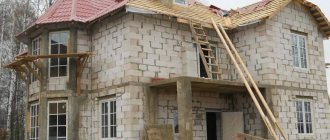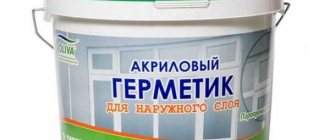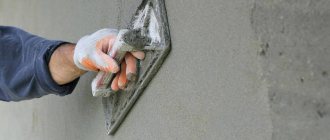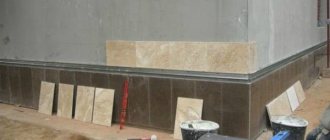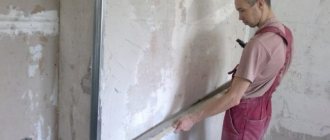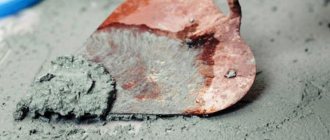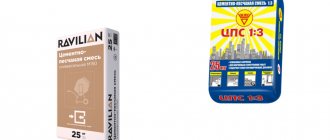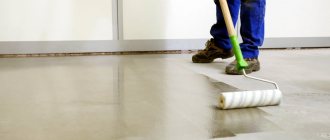Plastering is one of the popular methods of finishing facades. Its popularity is associated with ease of execution, affordable price and a large selection of texture options. This type of finishing is universal - it can be used to decorate both a private home and an office building. In this article we will look at what types of plasters are suitable for finishing the outside of a house.
Advantages of facade plasters:
- simplicity of application technology; you can plaster the walls outside the house yourself, even without experience in such work;
- good level of heat and sound insulation;
- resistance to air temperature changes;
- high level of strength;
- moisture resistance.
But besides the advantages, many types of decorative facade mixtures have a significant drawback compared to other finishing materials - this is a rather high price. But at the same time they have a small consumption of 2–3.5 kg per 1 m2.
Purpose
External plaster of concrete walls is equipped with:
- sanitary and technical parameters, due to which they obtain even and smooth wall surfaces with reduced dust formation and easier cleaning from dirt;
- protective and structural functions that make it possible to provide external walls with the proper level of protection from the harmful effects of dampness and aggressive environments, increased resistance to heat transfer, and reduced sound conductivity;
- decorative properties that allow you to give a special texture to the outer facade and provide a bright color to the surface. To do this, the composition varies the amount of fillers and binders, additives and pigments are used.
Return to contents
Advantages and disadvantages
The advantages of external plasters include:
- Possibility of selecting the optimal plaster mixture for high-quality finishing. The range of products of various compositions allows you to choose a material based on the size, type of wall material, and design project plans.
- Creation of a moisture-proof, vapor-permeable layer. Plaster breathes without interfering with natural air circulation, so moisture accumulates in the walls. This advantage allows you to create multilayer coatings.
- Possibility of obtaining a perfectly smooth and even surface.
- The ability to add relief to the finish.
- Suitable for cladding not only brick or stone masonry.
- Availability of insulated plaster mixtures coated with mineral wool or polystyrene foam.
- Laying the plaster mixture does not require preparation or leveling of the walls. Plaster compounds are used to seal seams, defects in masonry, protruding parts of the reinforcement frame, cracks, depressions, etc.
- Working with the mixture is quick and convenient.
- Low cost. Modern finishing materials (tiles, siding) for finishing wall cladding are more expensive than the process of external plastering of the facade.
- Ensuring high fire resistance.
- Durability. This advantage is relevant only when choosing high-quality plaster material and observing the nuances of application technology.
Facade plaster mixtures also have some disadvantages:
- It requires knowledge and experience in applying the topcoat to achieve a truly high-quality exterior coating.
- Multi-stage and labor-intensive implementation of facing work. The worker needs to properly dilute or prepare the plaster material, prepare the scaffolding, correctly divide the wall into sections for plastering, and properly level the surface treated with plaster.
- A large amount of waste when mistakes are made, which entails additional costs.
- You should work in sunny weather at average air temperatures. Precipitation in the form of snow or rain is undesirable, which can lead to peeling of the plaster due to high air humidity.
Return to contents
How to plaster concrete walls
Beginners are especially interested in how to plaster a concrete wall with their own hands. Therefore, below we provide detailed instructions for performing each work operation + videos.
The technology for plastering concrete structures includes:
- Surface preparation in accordance with standards.
- Impregnation (application) of the primer composition.
- Drying.
- Installation of reinforcing mesh (if provided).
- Applying tile adhesive as a future base
- Installation of beacon strips.
- Preparation of the solution.
- Performing spraying.
- Mixing the mixture, making soil.
- Preparing the coating mixture, applying the coating.
- Performing grouting.
Padding
If the plaster mixture is applied to a porous base, the wall will immediately begin to absorb water from the solution through near-surface pores and microcracks. When hardening, a dehydrated composition will not have enough water for the reactions to occur. As a result, a durable, durable coating is not formed.
To prevent the pores of the base from “robbing” the solution, a primer is used - coating the surface of the base with special compounds. The second reason for using a primer is to ensure reliable adhesion of the coating to the base material. An important task of primer compositions is antifungal protection.
Groups of plaster compositions
The goal of the process is to create a smooth, perfect surface.
There are three main groups of plasters:
- Classic plaster mixtures, which are intended for leveling surfaces for further finishing (painting, puttying, varnishing). They are endowed with high and specific protective properties, for example, when facing block wall materials such as aerated concrete, brick, cinder block. The most common is cement plaster.
- Decorative plaster products used as wall finishing. With their help, the masonry takes on a finished look. Plaster is used to decorate facades to create relief or colored surfaces. They differ in more complex application technology.
- Specific plasters designed to create a heat-insulating or shielding layer on walls. With their help, additional protection is provided from low temperatures, high humidity, noise, etc. The compositions are recommended to be applied under decorative plaster.
Return to contents
Do I need to plaster concrete walls?
Concrete is a high-strength, durable material that is most often found in construction. The surfaces of concrete structures are unsuitable for wallpapering or painting, as they cannot boast of evenness. The best option for finishing concrete, leveling and smoothing out unevenness, is plaster.
This is a material with sufficient strength, forming a monolithic, even coating.
Advantages of plaster finishing:
- versatility;
- workability;
- possibility of additional insulation, sound insulation;
- it is possible to create the creation of various textures or structures;
- wide selection of materials (both in price and in other parameters);
- maintainability;
- environmental friendliness, etc.
By plastering concrete walls, they are protected from moisture, mechanical stress, mold, efflorescence, UV rays, and other destructive factors.
Finish plastering can be done with decorative mixtures, thus imparting originality to the facade or interior, which corresponds to the aesthetic taste of the owner. Since a long life for plastered structures is ensured by adherence to technology and the right choice of plastering materials, it’s time to talk about them.
Types of finishing mixtures
There is a large selection of exterior concrete coatings available on the market. Conventional classification divides them into cement-sand and decorative plasters. A detailed description of the subspecies is presented below.
Return to contents
Mineral
They are most often used due to their low cost. Available in the form of dry plaster compositions. Prepared directly on the construction site. It is enough to dilute them with the required amount of water, according to the instructions on the package.
Mineral mixtures are applicable to finishing walls made of different materials: stone, brick, block products. Plaster is applied even to wooden surfaces after preliminary rough processing. For self-preparation, you will need a high grade of Portland cement and filler, which is selected according to the final requirements. Cement-based compositions with sand or lime filler are popular.
Peculiarities:
- low price;
- high strength qualities, adhesion, vapor permeability, frost resistance;
- low water absorption.
Disadvantages include:
- lack of color variety;
- low elasticity, which over time leads to cracking during shrinkage of load-bearing walls.
Return to contents
Acrylic
Acrylic structural plaster for external and internal use.
Acrylic mixtures are applied only to smooth surfaces. Due to its high elasticity, the minimum thickness of the facing layer is sufficient. The finished coating is wear-resistant. Suitable for finishing vapor-tight structures with polystyrene foam and polyurethane foam insulation.
However, the compositions are characterized by high cost, flammability, and low vapor permeability. Dust and dirt quickly settle on the plaster, which is why over time the facade loses its external aesthetics.
Return to contents
Silicone
This type of plasters has the highest performance parameters, increased elasticity, so the materials are easy to work with. Plaster compositions have the ability to maintain integrity during large shrinkages of the house, which makes it possible to create a high-quality outer layer when finishing gas silicate and foam block walls, which shrink significantly in the first year of operation, but require protection from rain and snow.
Features of the surface of silicone plasters:
- repels dust;
- washes quickly;
- retains color for a long time;
- suitable for finishing basement floors and buildings near the sea due to its high water resistance and resistance to sea salt.
Return to contents
Silicate
Silicate plaster in blue tones.
Silicate compositions are made from liquid potassium glass as a binder. The filler is: stone chips and/or sand, pigments, water, modifying additives. Is different:
- high moisture and wind protection;
- durability;
- high quality decorative finishing;
- good adhesion to concrete, silicate, aerated concrete;
- fire resistance;
- vapor permeability;
- tint variety of palette;
- possibility of finishing with silicate paints.
The only drawback is the high price.
Return to contents
Is it possible to leave a wet facade without finishing plaster for the winter?
It is not recommended to leave a wet facade without finishing plaster for the winter. The fact is that then the applied primer, which increases adhesion, may collapse. The work will have to be redone in the spring.
Some experts say that finishing plaster for the winter can be replaced with putty or paint. But others do not support them, explaining that there is a high probability of cracking of the facade. But, if the materials are selected correctly and experienced craftsmen work, then such a problem can be avoided.
Knowing how to choose the right plaster for exterior work and the peculiarities of its application, you can create smooth walls of the house yourself.
Criterias of choice
- Persistence. Acrylic plaster has the highest durability. This coating lasts up to 25 years. Silicate and silicone - 20 years, and external cement - 10 years. Silicone and acrylic plaster exhibit the highest resistance to weathering. Mineral and silicate mixtures require the inclusion of antifungal and antiseptic additives in their compositions.
- Texture. Smooth and even surfaces are more likely to crack due to high internal stresses. Rough walls are more durable and allow you to mask defects in the outer surface.
- Color. The durability of the color finish depends on the uniform distribution of paint or pigment in the outer layer, the antistatic properties of the plaster, the ability to repel dust, and resistance to UV rays. The most resistant in this regard is silicone plaster.
Table of operational parameters of external plaster for facade decoration
Return to contents
Options for applying facade plaster
Three main types of application technology:
- In one tone with the formation of a beautiful surface, very similar to the texture of natural stone;
- With a combination of one or more shades, formed by alternating light areas with dark ones. The surface can be “aged” if a silvered substance is used for this purpose;
- A special torn technique, when the formation of a patterned part is achieved by applying layers with different colors in a chaotic order. This way you can get a unique pattern.
If we talk about technical design, it can be textured, monolithic, or clearly imitating natural stone.
Finishing technology
The process of plastering may differ in nuances, depending on what type of surface is being plastered. Main technological stages:
- Surface preparation. Old finishing materials are removed, large cracks and potholes are sealed with cement plaster, bulges more than 1 cm thick are cut off, the concrete is cleaned of dust, the facade is divided into equal working sections.
- Kneading Store-bought mixtures are prepared according to the instructions by diluting with water to a sticky consistency that adheres well to the wall.
- Finishing work. The surface is pre-primed. When plastering with cement-sand compositions, the wall is wetted with water. For work, a trowel, spatula and other available tools are used. When the layer thickness is over 2 cm, it is recommended to use special mesh for plaster.
- Grout. During intermediate grouting, excess mortar is cut off. The waste can be used when mixing the next portion of the mixture. Finished walls are rubbed down with plastic or wooden trowels.
Return to contents
Preparing the walls
In order for the plaster to hold tenaciously, meet technical qualities, not be covered with stains of emerging rust or efflorescence, and serve for a long time, it is necessary to prepare concrete surfaces before plastering. That is, the surface at the time of applying the mixture must be clean, dry, and rough. There should also be no cracks, large shells, or excess metal inclusions.
Preparation procedure:
- Remove unusable old coating (whitewash, wallpaper, peeling plaster layers, paint);
- Protrusions and swells of concrete are cut down. The protrusions of cellular concrete are planed. To repair chips, cracks, and sinkholes, DSP with proportions of 1:3 is used. In case of large defects, “patches” are made with reinforcement.
- The smooth concrete surface is “speckled” with notches to increase adhesion.
- Remove excess metal elements, otherwise, once they rust, they will cause rusty streaks to appear on the finishing surface. The remaining metal objects are insulated using oil paint.
- The surface is cleaned of stains of various origins (foci of mold, grease, efflorescence, rust).
- Dust is swept or washed off the walls.
- The clean surface is primed and then dried.
- If the thickness of the plaster layer is ≥7 mm, beacons are installed.
- If the thickness of the leveling coating is large, a reinforcing mesh is attached to the concrete.
If hidden internal wiring is provided, then grooves are made when preparing the walls.
Examples of manufacturers
Top popular mixtures:
- German mixtures Caparol, Ceresit, Knauf are known for their high quality and medium price range. Produced in Eastern Europe and the CIS countries without loss of performance characteristics.
- Polish products Atlas, German mixtures Kreisel, Austrian materials Baumit, Ukrainian plastering compositions Polimin are distinguished by reliability and quality. Used for external and internal cladding of any surfaces.
- Russian Bolaris, Volma, Osnovit and Kazakh Synergy compounds are distinguished by mediocre performance. They occupy the lowest price segment.
Return to contents
